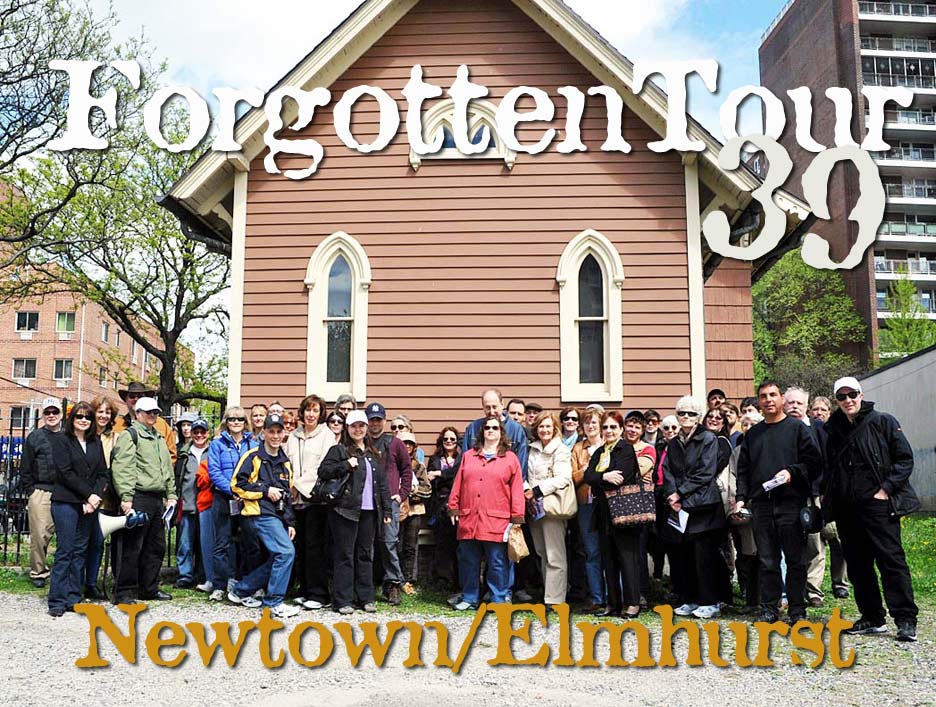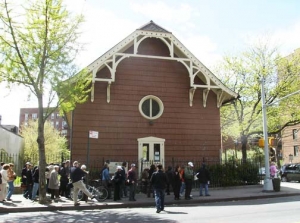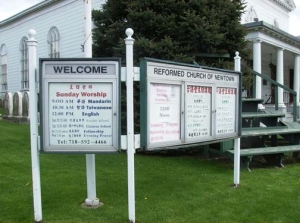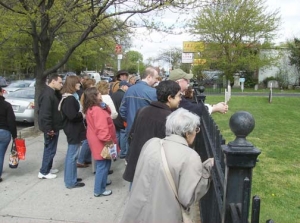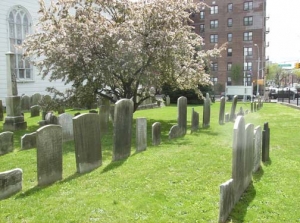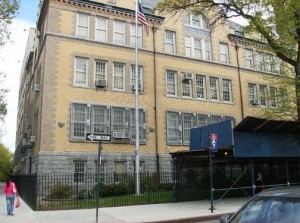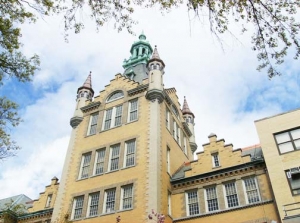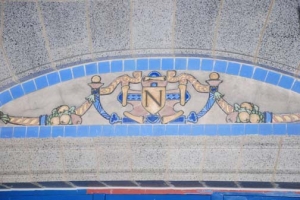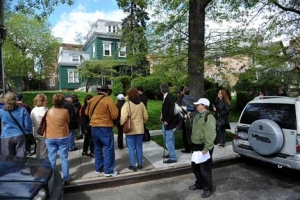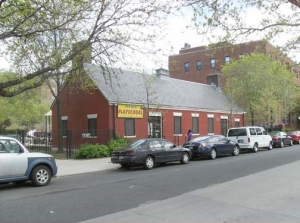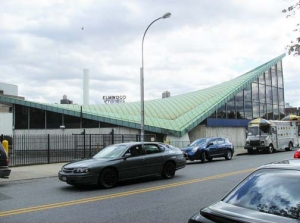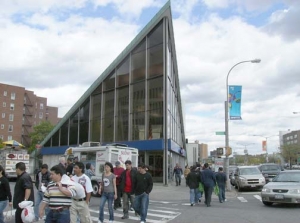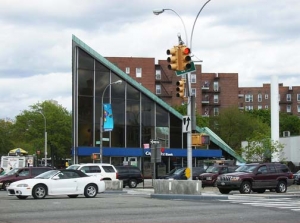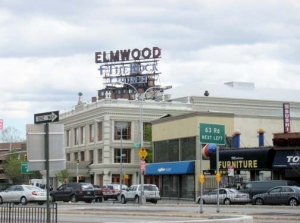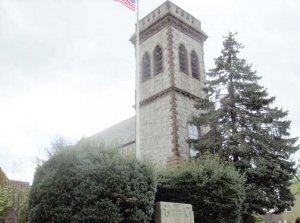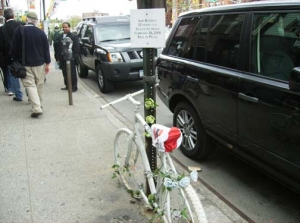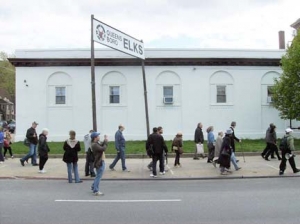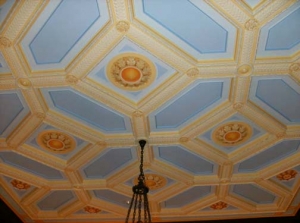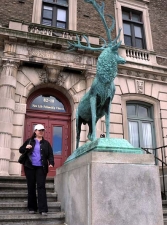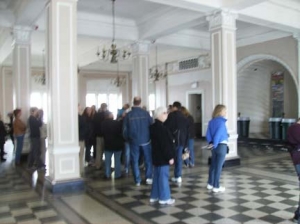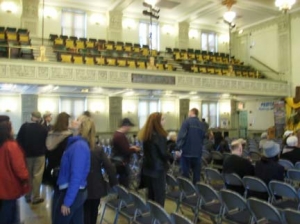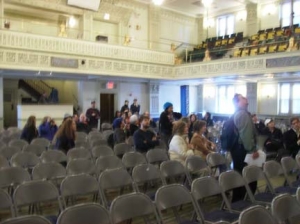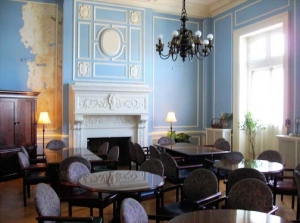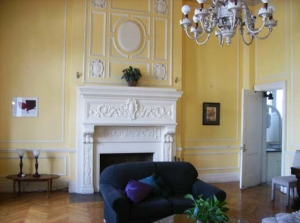On April 18th, 2010 the first ForgottenTour of the season (39th in the series that began June 1st, 1999 and second in association with the Newtown Historical Society), embarked under partly cloudy and 60-degree conditions, as once again over 40 ForgottenFans and local history enthusiasts converged at the Grand Avenue-Newtown subway station. It turned out to be a 3-hour excursion, despite your webmaster’s newfound effort to bring things to a conclusion in two, if only to spare my worn vocal cords. On this occasion, though, we had a pleasant surprise at our last stop, extending the tour longer that I’d anticipated, which I will explain presently. Your webmaster is the man with the horn.
This was also the first tour to offer a detailed brochure featuring all the highlights of the tour, put together with the aid of NHS trustee Mitch Waxman of the Newtown Pentacle (and white NHS hat on the right in the photo above). Time permitting, I’d like to do a similar brochure for future tours. Tourgoers also received a year’s membership in the Newtown Historical Society. My job, as usual, was to research the various historic artifacts on our tour route, and mumble into the megaphone as usual when our tour route took us past one of them.
The Newtown Historical Society of Queens County was founded to educate the community about the history and evolution of the colonial villages that comprised Newtown Township in Queens County, NY. Newtown Township stretched from the East River to the Flushing River. Towns covered include: Maspeth, Elmhurst, East Elmhurst,Middle Village, Glendale, Ridgewood, Forest Hills, Rego Park, Woodside, Jackson Heights and Corona. That gives a wide expanse of territory for the NHS to explore. To give you an idea of how vast Newtown had become by the mid-1870s, check this Beers atlas plate.
Newtown, founded in the mid-1600s after its colonists had fled from Native American attacks further west in Maspeth — and building literally a “new town,” mocks NYC’s preservationists, who seemingly prefer to recognize only buildings and artifacts in Manhattan and prefer to lavish designations and titles on buildings in that borough while ignoring the amazing treasures in what are considered the outer boroughs. In Queens, along with Jamaica and Flushing, Newtown (renamed ‘Elmhurst’ by developer Cord Meyer in the 1890s) retains several edifices and locales that existed in the first decades after its founding.
The heart of old Newtown is at the now-intensely busy intersection of Broadway, Queens Boulevard and Grand Avenue. Broadway brings in traffic from Long Island City, Grand Avenue from Williamsburg and Maspeth, and Queens Boulevard, the Champs Elysees of Queens without the charm, connects Queens Plaza and Jamaica….
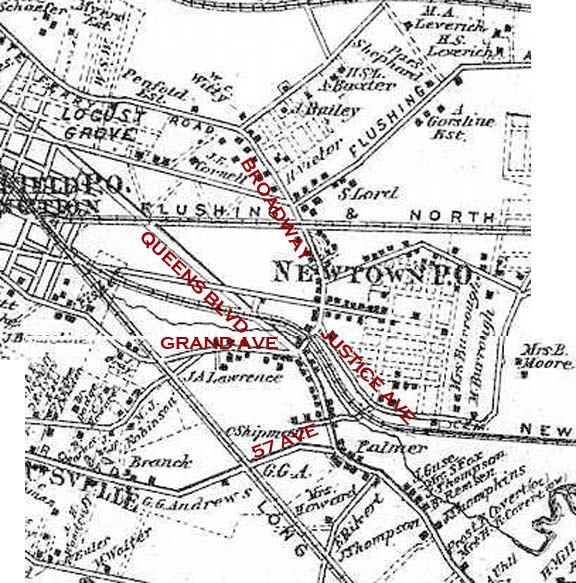
This is an excerpt from the 1873 Beers atlaslinked above. It shows the heart of Newtown at the junction of Newtown Plank Road, Hoffman Boulevard (Old Jamaica Road), and Hellgate Ferry Road, or today’s Grand Avenue, Queens Boulevard and Broadway.
Other notable routes in the area were Hempstead Plank Road, now 57th Avenue, the diagonal NE of Queens Boulevard, now Justice Avenue, and the road marked Flushing Avenue, now Elmhurst Avenue.
Note the “S. Lord” on the map on Flushing Avenue: this was Samuel Lord, the founder of the Lord and Taylor clothing store, now on 5th Avenue and West 38th Street. An immigrant from England, he settled for a time in Newtown and built four mansions on Claremont Terrace for his four daughters. Claremont Terrace is now a dirt driveway, and the only mansion left is in ruins.
Also: note the “Mrs. B. Moore” on the right side of he map. We will return to the Moore name presently.
The land where “H. Vietor” lived now bears a street called Vietor Avenue. Gorsline and Baxter also are remembered by streets today.
In the title card ForgottenFans are standing outside the Old St. James Church at Broadway and 51st Avenue, the first stop on the tour. Here are two views, pre-renovation in 2002, and post-renovation in 2010. This is the oldest building in Elmhurst and among the oldest in Queens; only two buildings in Flushing, the Quaker Meetinghouse and John Bowne House, are older than this building. It is a relic of colonial rule, having been chartered by George III and erected in 1734: it is Elmhurst’s oldest remaining building. It formerly supported a clock tower that a storm blew down in 1882. Last used as a church in 1848, it is now a community center and Sunday school. In recent years the over-260-year-old building has received some much-needed TLC. A ‘new’ St. James, built in 1848, also burnt down; its replacement is an A-frame brick building on Broadway and the NE corner of Corona Avenue.
Jim Driscoll of the Queens Historical Society describes the church thusly on the Preserve and Protect website:
The ancient unadorned building located at the corner of 51st Avenue and Broadway is the original St. James Episcopal Church of Newtown (now Elmhurst). According to Riker’s Annals of Newtown, the frame for the building was raised in 1735. When the first service was held is not clear but the pews were not installed until 1740. The family names of the people who were assigned those first pews reads like a who’s who of Queens colonial history: Moores, Sacketts, Alsops, Blackwells, Hazards and Halletts.
At the time of its construction, the church was officially a chapel of the Grace Episcopal Church in Jamaica. Both Newtown and Flushing were part of the Jamaica parish. The Newtown congregation was given the right to have its own parish and hire its own minister in 1761 but for some unknown reason it failed to do so at the time. It wasn’t until 1809 that St. James permanently became a separate parish.
With the start of the Revolution, many of the congregation members who were patriots fled Newtown. The Reverend Joshua Bloomer would continue to conduct Anglican services at the church swearing allegiance to the king. He would minister to the remaining congregants: Tories and British army officers stationed in Queens. Some old newspaper articles claim that such well known British leaders as Lord Cornwallis attended services at St. James. However, the 19th century histories of Queens by Riker and Munsel make no mention of this.
The building looked different in the 19th century. Most significantly, there was a large square tower topped by a steeple and spire attached to the rear of the building. Also, although very little information about this appears to exist, there was a small cemetery directly behind the church. A 1908 City History Club walking tour guide for old Newtown mentions a badly maintained graveyard in back of old St. James, which indicates that it still existed at this late date.
Check that link — much, much more on this unheralded city landmark.
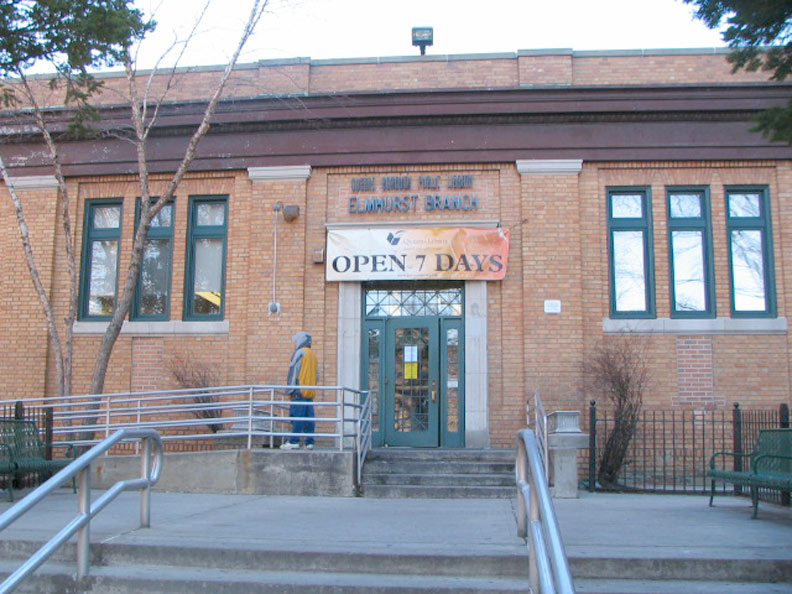
Directly across Broadway from Old St. James is the Elmhurst Branch of Queens Public library, built in 1908 and one of a number of libraries in NYC funded by steel magnate/philanthropist Andrew Carnegie. The Queens Library is planning to raze the structure, maintaining that it is too small to meet the needs of the burgeoning area population. The NY Landmarks Conservancy has petitioned for its survival.
The Elmhurst Library Branch, located on Broadway in the “historic center” of the community, was one of 1,689 free libraries built nationwide between 1883 and 1929 with funds donated by Andrew Carnegie. The Elmhurst branch was opened to the public in 1906 as one of the first Carnegie libraries. The Georgia Revival-style building carried a $46,000 price tag and boasted turn-of-the-century architectural features such as eye windows, balustrades and cornices, most of which have been removed over the years. Queens Gazette, linked above.
On Broadway between 51st and Corona Avenues is the Reformed Dutch Church of Newtown, built in 1831, enlarged in 1851 with stained glass added in 1874. It replaced an older structure built in 1733. On the Corona Avenue side is an ancient graveyard with some Dutch stones. Some are quite old, going back to the first days of the congregation; the older stones are brownstone with uneven tops, and the lettering in most cases is much more readable than younger marble stones, which deteriorated faster. Today’s congregation is mainly Asian and the prayer service languages duly reflect this.
The tour traveled for a time on zig-zaggy Corona Avenue, which, if you look at a map, is shaped like an M. The avenue was created by joining several roads that traveled in one direction, then another. At 90th Street we turned right and glimpsed…
One of the most distinctive buildings in Queens is the 169-foot tall, five-spire-tower Newtown High School at Corona Avenue and 90th Street. It was designed in a Flemish Renaissance style by C.B. J. Snyder and completed in 1921. The front of the building is shrouded under a sidwalk canopy but recent tower renovations are complete. Newtown High’s first graduating class in 1894 was one student; today over 4000 students attend.
We noticed some engaging tile and terra cotta work at the front entrance.
The next couple of items on the tour concerned locales that are no longer in evidence but still have left some small traces to inspect. At 90th Street, 56th Avenue and Justice Avenue, there is a very old house, re-sided in the near past, but still complete with a mansard roof and dormer windows. It must have been there when the brook that was here flowed past, and it also might well have been here when steam trains hustled through. Justice Avenue (which is marked on the map above) runs diagonally to the local street grid because it followed the course of the old Newtown and Flushing Branch of the Long Island Rail Road — known popularly in its era as the White Line. It branched from the present main line in eastern Woodside and connected with the Port Washington line at what is now Main Street, and served Newtown and what was then West Flushing and is now Corona. It ran only from 1873-1876, so its inclusion on the 1873 Beers Atlas was serendipitous. Historian Art Hunecke has the whole White Line story at Arrts Arrchives.
Horse Brook was once an over-ground stream running from Justice Avenue and 56th Avenue west to about Codwise Place and Grand Avenue and emptying into the Flushing River. It has long been diverted underground. Sergey Kadinsky has the whole Horse Brook story on this FNY page.
RIGHT: a playground at 56th Avenue and 92nd Street contains the remnants of a Newtown burying ground, with the remains of several prominent families such as the Moores (who produced Clement Clarke, credited with writing the classic “‘Twas the Night Before Christmas” and the Fish family, which has produced several statesmen including a NY State Governor and a US Representative. The burying ground was converted into a park in 1935, though the dead were not disinterred: they still lie beneath a portion of the park that was left empty but for a grass covering with cherry and beech trees.

The former Jamaica Savings Bank on Queens Boulevard and 56th Avenue exhibits phases, like the moon, depending on where you view it. From 56th Avenue it resembles a verdigri’ed Stealth bomber, while its glassy triangle is unmistakable from other angles across the Boulevard of Death. Currently, it is home to a branch of Capitol One: it has always been a bank.
The arrival of the World’s Fair in Flushing Meadows in 1964 was symbolic of the Swingin’ Sixties, space-race go-go attitude the country had at the time; the war in Vietnam had not yet become an albatross and there seemed to be a boundless enthusiasm about the future and the wonders it would produce. Architects seemed to get the message as well and it was then that several extraordinary buildings were produced along Queens Boulevard. George Jetson would feel at home zipping by the sweep-angled, glass-fronted edifice.
Local Philistines in the City Council overturned the Landmarks Preservation Commission’s decision to designate it. Rumor has it that some neighborhood loons would like it torn down in favor of a more conventionally designed building. I hope it stands there forever.

Yet another innovative architectural Queens Boulevard piece is the circular R.H. Macy branch, seen here behind the Jamaica Savings Bank. This was the site of an epic struggle between The World’s Biggest Store and a local homeowner, Mary Sendek (some accounts spell it Sondek). Mary and husband Joseph had purchased property at Queens Blvd. and 55th Avenue in 1922 and built a modest home there, raising a family; when Macy’s arrived after Joseph Sendek’s death and offered to buy the property, Mary refused to budge, even after Macy’s offered her five times what the Sendeks spent when they purchased the property. Macy’s eventually cut a notch in the circular structure to evade the property line. In a similar case, Forest City Ratner recently [April 2010] paid holdout Daniel Goldstein $3MM (also five times what he paid for his property) to end his years-long battle to retain his Pacific Street property, which was holding up the downtown Brooklyn Atlantic Yards mega-project.
The former Elmwood Theater, Hoffman Drive and 57th Avenue, is at the former Newtown junction of Hempstead Plank Road and Hoffman Boulevard. The plank road is now 57th Avenue and Hoffman Boulevard was expanded in 1910 to a behemoth connecting the Queensboro Bridge and the town of Jamaica. The Elmwood was built in 1928 by architect John Schladitz as the Queensboro, and offered vaudeville stage shows and moving pictures. After closing off and on during the Depression and WWII, it was reopened as the Elmwood in 1949 and prospered in the postwar years, until it closed as a theater in 2002 and purchased by the Rock Community Church, which renovated the exterior.
The brownstone and granite Gothic First Presbyterian Church of Newtown at 54th Avenue and Queens Boulevard was constructed in 1895 by architect Frank Collins with $70,000 donated to the church in the will of one of its elders. When Queens Boulevard was constructed in 1910 the church had to be moved back several feet. The congregation of the church goes back to Newtown’s earliest era — founded in 1695 with first minister Rev. John Moore, of the famed Moore local family. Several congregants signed the Flushing Remonstrance, a 17th-century demand for religious tolerance by Flushing’s Quakers. There is a time capsule in the cornerstone.
In February the Newtown Historical Society presented a chat and slideshow at the church regarding the return of the Newtown Pippin apple to the town of its origin. The original apple tree was located on the Gershom Moore farm along a tributary of Newtown Creek in the 1700s. From it, cuttings were taken and planted in orchards throughout the world. The apples were cultivated by some of our country’s founding fathers, including George Washington and Thomas Jefferson.
The church was the site of a planting in 2002 which brought the apple back to its area of origin for the first time since the early 19th century. In 2009, additional trees were planted as part of the Newtown Pippin Project.
RIGHT: on Queens Boulevard the tour encountered a white “ghost bicycle.” The bikes are placed by a bicycle advocate organization wherever a bicyclist has been struck and killed by a moving vehicle.
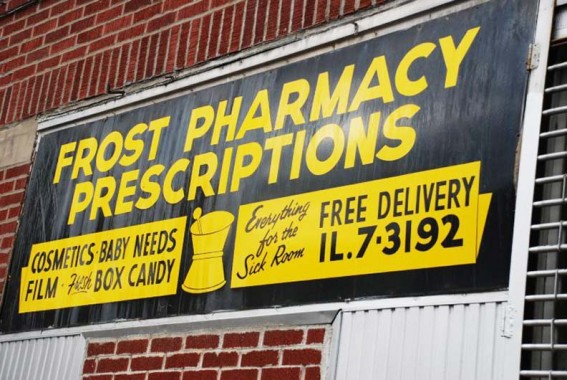
I often encounter objects I didn’t previously know about on ForgottenTours. There’s this terrific Frost Pharmacy sign on 55th Avenue and Queens Boulevard. The color combination is my favorite one (my bathroom at chez Forgotten is yellow and black tile, and it influenced my purchase of the apartment). The sign was hand lettered using, most likely, stencils, rulers, T squares and protractors. Then there’s the outdated language: “baby needs,” “box candy,” “sick room.” I used a film camera to shoot pictures for the ForgottenBook, but who knows how much longer photography film will be produced. The vessel with the pestle drugstore symbol. Additionally, the letter telephone exchange: IL for Illinois. This is one monster sign and like the Jamaica Savings Bank, I hope it’s there forever.
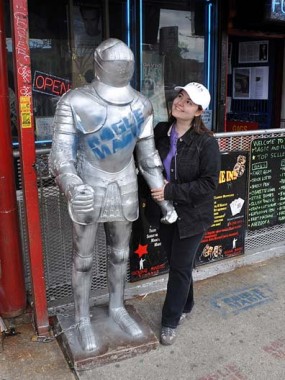

NHS President/FNY Correspondent Christina Wilkinson found a knight in shining armor at Rogue Magic, 85-08 Queens Boulevard near Grand Avenue. Meanwhile the “gravy” train will soon end on Queens Blvd. as the G will end its run at Court Square and the V will be replaced by the M, which will then be in an orange bullet for the first time in its existence. It’s like your webmaster putting on shorts.
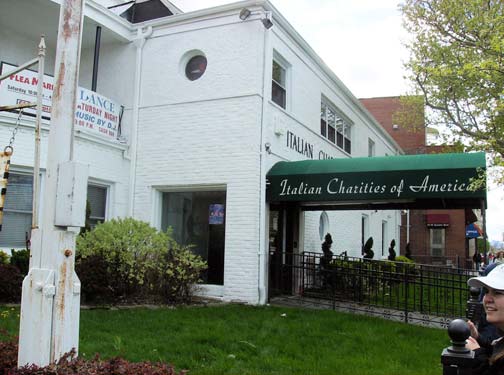
I’m largely in the dark about the Italian Charities of America and its unusually-shaped building on Queens Boulevard and Van Loon Street, so I’ll let them speak for themselves…
Italian Charities of America was founded in 1936. It was established to assist Italians and Italian-Americans in need during the great depression in New York City. Its mission was to provide charitable assistance. It has provided support to disabled children, cerebral palsy organizations, cancer patients, retired members of religious orders among others. Italian Charities of America is also a social and cultural center for those of Italian origin in the greater New York City area. It offers weekly Italian language classes for children and adults. Ballroom dancing lessons are offered twice weekly. Dinner Dance events are held two Saturdays per month.

Oof, I forgot to get a good shot of the last stop on the tour, the grand Elks Lodge on Queens Boulevard and Simonson Street. (Do I use Google Earth? Of course I do, and I enjoy it). Local 878 was once the largest Elks Lodge on the East Coast with 60 rooms, bowling alleys, billiards, a ladies’ lounge, and a 50 foot bar, built in the teeth of Prohibition in 1924. The Elks don’t own the old place any more: it’s been sold to the New Life Fellowship, but the Elks remain as tenants. The Ballinger Company designed the granite, limestone and brick structure dominated by a now-verdigris-covered elk at the front entrance. For a couple of decades, Extreme Championship Wrestling (the old ECW, now folded into Vince McMahon’s WWE) bouts were held here featuring some of the legends of “sports entertainment” such as the Sandman and Mick Foley. The Elks Lodge is an official New York City Landmark.
FNYers walked past the swimming pool natatorium and Christina checked out the famed verdigris’ed elk (the prototype for all such sculptured Elks Lodge elks) … and Mitch finagled our way in, where Elks Lodge caretaker Dave showed us around the building. The multicolored ceiling in the lobby is wood paneling redone to hide damage accrued through the years.
1995:
Three decades ago, the lodge’s 6,600 members included some of the borough’s most prominent residents. The Elks raised funds for charity, held grand balls and otherwise reveled in their own brotherhood. “This was the place to be,” recalled Paul Reilly, 61, a retired police detective. “You’d have to fight to get near the bar.”
The struggle to hold on is becoming more difficult for Lodge No. 878, which retains its traditional, if not official, all-white membership. The need to compromise with reality has gotten to this point: the nation’s 2,250 lodges will vote next month on whether to allow female Elks. “Things wouldn’t be the same with women sitting at the bar,” said Bernie Dulke, 70, the lodge’s secretary and a professional church organist. “But I guess you got to roll with the times.”
The old fraternal organizations like the Elks, Masons and Shriners are becoming anachronistic. Its charitable and benevolent functions have largely been taken over by the government.
With its old-fashioned values, unapologetic patriotism and arcane rituals, Elkdom seems like a relic to younger generations. The lodge chief is called an Exalted Ruler, top-level officers are called Knights, and the induction ceremony is an elaborate ritual closed to outsiders. Initiates must be American citizens, have the endorsement of three members and “believe in the existence of God,” according to a promotional brochure. Women can only participate in Elk activities through the Ladies Auxiliary. Blacks were barred until 1973 and efforts to include them and other minorities since then, at least in Elmhurst, are open to question.
The upstairs meeting hall was where the ECW held matches with the ring in the center of the all…wrestlers would often jump off the balcony. The Aztec-themed hall has rankled some New Life Fellowship congregants, who think the Aztec imagery looks satanic. They are attempting to arrive at a coverup compromise that won’t entail taking any of the sculpting down.
Sitting rooms near the front of the building included the Ladies’ Lounge, right.
That concluded the tour — but the NHS plans for a few more in 2010 and beyond. Thanks to Bernard Ente, Joe DiMarco and Pat Sweeney for their contributions to this page. To contact the Newtown Historical Society, email newtownhistory@gmail.com or call 718 366-3715.

